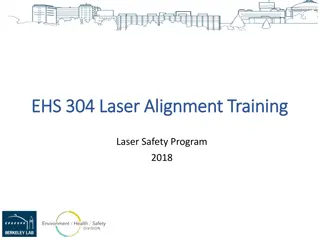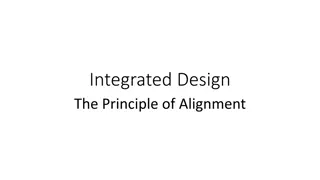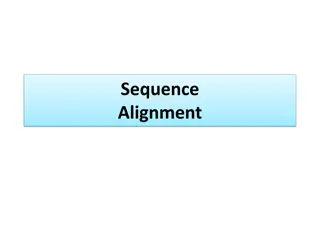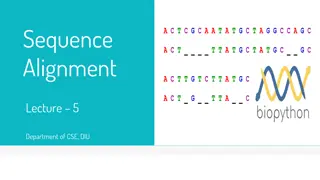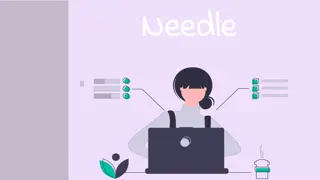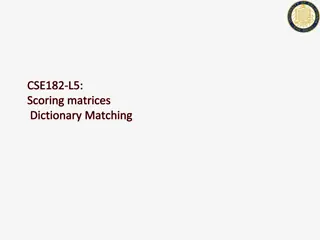Simplifying Course Alignment for Academic Success
Exploring the importance of alignment in courses, this guide provides insights on understanding course descriptions, determining course levels, and aligning instructional activities. Learn how to enhance productivity and mastery of knowledge and skills among faculty and society members.
Download Presentation

Please find below an Image/Link to download the presentation.
The content on the website is provided AS IS for your information and personal use only. It may not be sold, licensed, or shared on other websites without obtaining consent from the author.If you encounter any issues during the download, it is possible that the publisher has removed the file from their server.
You are allowed to download the files provided on this website for personal or commercial use, subject to the condition that they are used lawfully. All files are the property of their respective owners.
The content on the website is provided AS IS for your information and personal use only. It may not be sold, licensed, or shared on other websites without obtaining consent from the author.
E N D
Presentation Transcript
Simple Tools That Make Alignment Easy Judy Meier Penn and Livia Marly Sa Shoreline Community College
Why Alignment? FACULTY COLLEGE SOCIETY expects members to be productive, to have mastered knowledge & skills for their professions Programs Courses Course Instructional Materials Course Activities Course Description
Why We Struggle with Alignment My Public Perception of My Course Personal Beliefs About My Course
Steps in Alignment 1. Look at your course description. This is what the public sees about your course. Ask others to look at it! What Bloom s category best fits this description? Is this course mostly about understanding, knowledge? Or, is it more hands-on application of information? Or, is it mostly philosophical, analytical?
Activity 1. At what level is this course taught? BIOL 124. Northwest Flora. Plant classification, field study, and laboratory identification of common Pacific Northwest plant families and investigating the ecology, cultural uses & conservation of plants at the local & global level. Laboratory. Knowledge Remember previously learned information. Comprehension Demonstrate an understanding of the facts. Application Apply knowledge to actual situations Analysis Break down objects or ideas into simpler parts; find evidence to support generalizations. Synthesis Compile component ideas into a new whole or propose alternative solutions. Evaluation Make and defend judgments based on internal evidence or external criteria
Activity 1. At what level is this course taught? HIIM 235 Health Information Technology Capstone Course. Student teams research and present business plans for a new clinic health information department. Investigate, select and present department functions, job descriptions, supplies/ equipment list, policies, procedures, flow charts, layout, and budget according to team-developed planning time table. Knowledge Remember previously learned information. Comprehension Demonstrate an understanding of the facts. Application Apply knowledge to actual situations Analysis Break down objects or ideas into simpler parts; find evidence to support generalizations. Synthesis Compile component ideas into a new whole or propose alternative solutions. Evaluation Make and defend judgments based on internal evidence or external criteria
Steps in Alignment 2. Next, look at your Course Activities Activities = Learning Activities (readings, assignments, exams, what students are DOING in your course) Do these activities mostly fall under the Bloom s category that you selected for the course description?
Activity 2: Do Activities Match Blooms Level? PHIL 240. Introduction to Ethics. Examination of historically significant philosophical theories of right and wrong, good and bad, human rights, and ideals of freedom emphasizing classic writers such as Plato, Confucius, Aristotle, Augustine, Aquinas, Hobbes, Locke, Hume, Kant, Mill, Marx, Nietzsche, and Rawls. Course Activities: 8 Multiple Choice Quizzes Reading assignments Daily Lectures Comprehensive Multiple Choice Final Exam Knowledge Remember previously learned information. Comprehension Demonstrate an understanding of the facts. Application Apply knowledge to actual situations Analysis Break down objects or ideas into simpler parts; find evidence to support generalizations. Synthesis Compile component ideas into a new whole or propose alternative solutions. Evaluation Make and defend judgments based on internal evidence or external criteria
Steps in Alignment 3. Module Objectives Do you have them? If not, create them from your Course Activities
Steps in Alignment 4. Compare Module Objectives & Activities QM Alignment Table by Livia Marly Sa is licensed under a Creative Commons Attribution-NonCommercial 4.0 International License.
Steps in Alignment 4. Compare Module Objectives & Activities ?
Steps in Alignment 5. Compare Module & Course Objectives Alignment Table by Judy Meier Penn is licensed under a Creative Commons Attribution-NonCommercial 4.0 International License.
Steps in Alignment 5. Compare Module & Course Objectives
Summary of Steps in Alignment 1. Review Course Description and assess dominant Bloom s level. 2. Do Course Activities (as a group) mostly fit that same Bloom s level? 3. Create Module Objectives from Course Activities (if needed) 4. Check Alignment of Module Objectives and Course Activities 5. Check Alignment of Module Objectives with Course Objectives WOO-HOO! Your Course is Aligned!
Questions? Resources (Posted on Conference Site) Copy of Presentation Slides Bloom s Taxonomy Verb List Templates: Table for Alignment of Course & Module LOs BIOL 126 Table for Alignment of Course & Module LOs QM Alignment Table Template For More Information: jpenn@shoreline.edu Thanks for attending!









